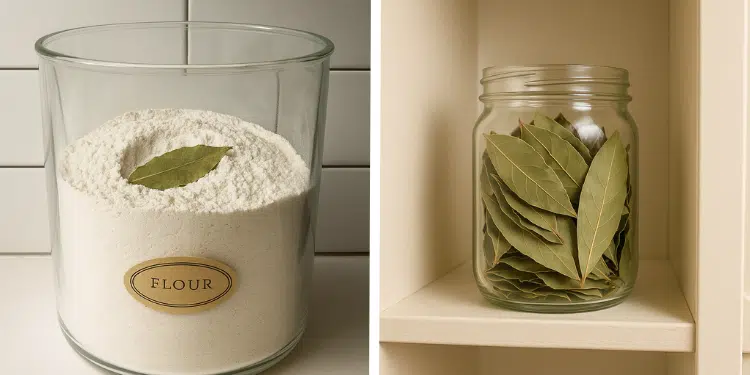3. Natural Air Purifier and Stress Reliever
Beyond symbolism, bay leaves offer real physical benefits backed by science. Their essential oils – including cineole, eugenol, and linalool – have potent antimicrobial, antifungal, and calming properties.
When placed in warm, dry corners or lightly warmed on the stove, bay leaves:
- Neutralize cooking odors.
- Repel pests like moths, ants, and cockroaches (more on that below).
- Release relaxing aroma compounds that help reduce stress and anxiety.
Try This Ancient Yet Practical Trick:
Burn a single dried bay leaf in a heatproof bowl for 5–10 minutes once a week. The gentle smoke acts as a natural incense that:
- Purifies indoor air.
- Clears the mind after cooking or conflict.
- Brings an earthy, peaceful energy to the kitchen.
Studies suggest that the scent of linalool – abundant in bay leaf oil – may reduce cortisol levels and promote calmness, supporting what our ancestors instinctively knew centuries ago.
4. An Ancient Insect Repellent Still Working Today
The ancients may not have known the chemistry, but they understood results. One of the main reasons people placed bay leaves around the home – especially in kitchens and pantries – was to repel insects naturally.
Why It Works:
Bay leaves contain essential oils (especially eucalyptol and cineole) that pests find overwhelming. Their strong, aromatic compounds deter:
- Cockroaches
- Moths
- Ants
- Weevils and grain beetles
How to Use Bay Leaves for Pest Control:
- Place whole dried bay leaves in pantry shelves, flour containers, rice jars, and around baseboards.
- Replace them every 2–3 months or when the scent fades.
- You can also add a few drops of bay essential oil to a cotton ball and tuck it behind appliances.
This natural repellent is safe, affordable, and eco-friendly – no chemicals, no fumes, and no harm to pets or food.
So, while ancient people might have believed they were keeping away “evil spirits,” they were also unknowingly protecting their food from infestations – proof that folklore often hides scientific truth.
5. A Symbol of Healing and Protection
In herbal medicine, bay leaves have been valued for centuries as a powerful healing herb. The Greeks called the laurel tree “the plant of the gods,” and Roman soldiers burned its leaves before battle for courage and immunity.
Modern studies confirm bay’s natural properties:
- Antimicrobial and antifungal: Helps reduce pathogens in the air.
- Anti-inflammatory: The oils soothe joints and muscle pain.
- Respiratory support: Steam from bay leaf tea or vapor clears congestion.
This is why in many traditional households, bay leaves were hung or placed near stoves – both as a health charm and as a practical way to infuse their scent into the home.
6. Spiritual Grounding and Emotional Balance
Energy healers and aromatherapists regard bay leaves as a grounding herb that restores emotional stability.
The scent of bay leaf promotes focus, strength, and calm – qualities associated with its ancient symbolism of wisdom and victory.
When burned or crushed, bay leaves are believed to help:
- Clear mental fog.
- Reduce stress and anxiety.
- Strengthen intuition and motivation.
That’s why it was often used by philosophers and poets in ancient times – bay was considered a herb of inspiration.
Placing it in your kitchen (where energy is often chaotic from movement, heat, and smells) helps create a sense of balance and calm.
7. Bay Leaf in Feng Shui and Energy Flow
In Feng Shui, the kitchen is linked to the element of fire – representing wealth, vitality, and transformation. However, it’s also prone to energetic imbalance, especially if cluttered or neglected.
Placing bay leaves in corners or near the stove harmonizes the energy flow by:
- Balancing the fire element with bay’s grounding earth energy.
- Encouraging abundance and health.
- Protecting against negative chi (stagnant or draining energy).
For best results:
- Place one bay leaf in each corner of the kitchen for stability.
- Refresh them monthly.
- Combine with a bowl of salt or citrus peel for cleansing synergy.
It’s a small, elegant way to align your space with both ancient tradition and modern energy wisdom.
8. How to Use Bay Leaves in Everyday Kitchen Magic
Bay leaves aren’t just for soups and stews – they’re one of the most versatile natural tools for both physical and energetic well-being.
Here are a few creative ways to use them at home:
1. Bay Leaf Floor Wash (for Energy Cleansing)
Boil 5–6 bay leaves in water for 10 minutes. Let it cool, strain, and add to your mop bucket. Use this herbal water to wash your kitchen floor – believed to clear negativity and bring renewal.
2. Simmer Pot for Peaceful Atmosphere
Simmer bay leaves with cinnamon sticks, orange peels, and cloves. The aroma neutralizes kitchen odors and fills the house with warmth and serenity.
3. Bay Leaf Sachets
Tie a few dried bay leaves in small fabric bags and hang them in kitchen corners, cupboards, or near the trash area. They act as natural deodorizers and subtle protective charms.
4. Burn a Bay Leaf Weekly
A weekly bay leaf burn ritual is said to “reset” your home’s energy. Simply burn one dried leaf in a safe dish, focusing on gratitude and renewal.
5. Add to Tea or Bath
For relaxation, add a few crushed bay leaves to boiling water to make tea – or steep them in your bath for muscle relief and grounding energy.
The Science Behind the Tradition
While much of the bay leaf’s spiritual symbolism comes from ancient lore, modern science supports many of its practical benefits:
| Traditional Belief | Scientific Explanation |
|---|---|
| Wards off bad energy and illness | Bay leaf essential oils have antibacterial and antifungal properties. |
| Promotes calm and focus | Compounds like linalool and cineole have stress-reducing effects. |
| Protects stored food from pests | Bay leaves repel insects due to their strong aroma and volatile oils. |
| Purifies air | Burning or simmering bay leaves releases antimicrobial vapors. |
| Symbol of prosperity | The evergreen nature of the plant represents vitality and renewal. |
In short, the tradition of placing bay leaves in your kitchen is both symbolic and functional – blending aromatherapy, pest control, and mindfulness into one elegant practice.
How to Choose and Care for Bay Leaves
If you want to keep bay leaves in your kitchen for both energy and practicality, here’s how to get the most out of them:
- Use organic dried leaves (fresh if you have a bay laurel plant).
- Replace them every 4–6 weeks to keep the aroma strong.
- Store unused leaves in an airtight jar away from light.
- To refresh dried leaves, warm them gently in your oven for a few minutes at 120°C (250°F).
If you’re lucky enough to grow your own bay laurel plant, it can thrive indoors near a sunny window. It’s evergreen, low-maintenance, and adds a touch of Mediterranean beauty to your kitchen.
From ancient temples to modern homes, bay leaves have traveled through time as a symbol of protection, purification, and prosperity.





